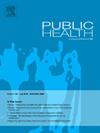通过废水分析分析越南河内6年的酒精消费量:评估受社会经济因素影响的变化
IF 3.9
3区 医学
Q1 PUBLIC, ENVIRONMENTAL & OCCUPATIONAL HEALTH
引用次数: 0
摘要
越南的酒精消费量在过去十年中随着经济的发展而显著增加。然而,近年来,包括新的酒驾法和税收在内的几项酒精控制措施以及COVID-19大流行影响了消费水平。这项研究旨在连续六年监测河内市的酒精使用趋势。研究设计我们对2018年至2023年酒精消费的废水流行病学(WBE)进行了时间序列分析。方法从约40万人的集水区每年连续收集至少30天的废水样本中测量硫酸乙酯(酒精消耗的生物标志物)。结果调查结果显示,酒精消费量呈明显下降趋势,年均下降7.51%。在一周的所有日子里,包括在COVID-19大流行期间,消费量保持稳定。最明显的减少发生在2020-2021年期间,恰逢COVID-19限制措施。从2022年开始,酒类消费出现反弹迹象,与全国销售趋势一致。此外,注意到从贸易内(例如酒吧/餐馆)到贸易外(以家庭为基础)的明显转变,这可能反映了与大流行有关的限制和严格的酒驾法的执行。结论研究期间河内市饮酒环境的酒精消费趋势和变化可能受到公共卫生措施和政策干预的综合影响,包括COVID-19大流行和严格的酒驾法。本研究成功地利用WBE对资源有限地区的酒精使用情况进行了相对低成本的纵向监测,为公共卫生政策的制定提供了必要的证据。本文章由计算机程序翻译,如有差异,请以英文原文为准。

Six years of alcohol consumption in Hanoi, Vietnam, by wastewater analysis: Assessing changes impacted by socio-economical factors
Objectives
Alcohol consumption in Vietnam increased significantly over past decade alongside its economic development. However, in recent years, several alcohol control measures including a new drink-driving law and taxes as well as the COVID-19 pandemic have affected the consumption levels. This study aimed to monitor alcohol use trends in Hanoi over six consecutive years.
Study design
We conducted a time series analysis of wastewater-based epidemiology (WBE) for alcohol consumption from 2018 to 2023.
Methods
Ethyl sulfate, a biomarker for alcohol consumption, was measured in wastewater samples collected consecutively for at least 30 days each year from a catchment of approximately 400,000 people.
Results
The findings revealed a clear downward trend in alcohol consumption, with an average annual decline of 7.51 %. Consumption remained stable across all days of the week, including during the COVID-19 pandemic. The most pronounced reduction occurred during 2020–2021, coinciding with COVID-19 restrictions. From 2022 onwards, signs of a rebound in alcohol consumption were observed, consistent with the national sales trends. Additionally, a marked shift was noted from on-trade (e.g., bars/restaurants) to off-trade (home-based), likely reflecting both pandemic-related restrictions and the enforcement of the strict drink-driving law.
Conclusion
Alcohol consumption trends and shifts in drinking settings in Hanoi during the study period were likely influenced by a combination of public health measures and policy interventions, including the COVID-19 pandemic and the strict drink-driving law. This study successfully used WBE for relatively low-cost longitudinal monitoring of alcohol use in resource-limited settings, providing necessary evidence for public health policy formulation.
求助全文
通过发布文献求助,成功后即可免费获取论文全文。
去求助
来源期刊

Public Health
医学-公共卫生、环境卫生与职业卫生
CiteScore
7.60
自引率
0.00%
发文量
280
审稿时长
37 days
期刊介绍:
Public Health is an international, multidisciplinary peer-reviewed journal. It publishes original papers, reviews and short reports on all aspects of the science, philosophy, and practice of public health.
 求助内容:
求助内容: 应助结果提醒方式:
应助结果提醒方式:


